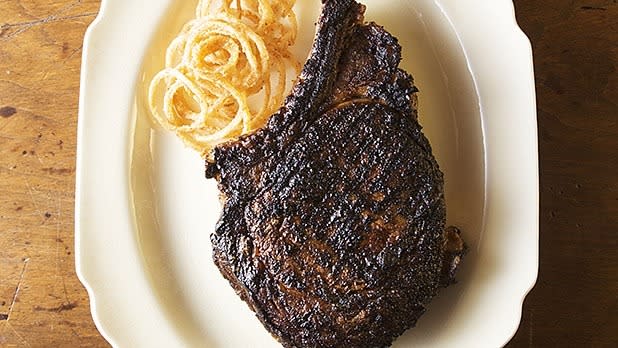How to Make the Perfect Ribeye Steak

(Photo: Andre Baranowski / Getty Images)
By Janet Potter
Often the crown jewel of the steakhouse menu, a well-prepared ribeye steak is a beautiful thing. We spoke with Dino Tsaknis, Executive Chef at David Burke’s Primehouse at The James Chicago, about what makes it uniquely delicious, and how the amateur cook can tackle it at home.
The ribeye comes from the loin muscle (longissimus dorsi), a long muscle that stretches along the spine from the base of the neck to the hip, outside of the rib cage. They are cut from the top of the muscle, just behind the shoulder (followed, as you travel down the spine, by the strip and the porterhouse). As a little-used part, steaks from the loin are particularly tender, but Tsaknis prefers the ribeye to the strip. As he says, “the ribeye has a more decadent flavoring of richness and butteriness, whereas the Kansas City strip features more of a straightforward meat flavor.”
Related: How to Cook a Steak to Perfection
He goes on to explain that the ribeye’s high-fat content “offers generous marbling, and therefore, the meat has more moisture to cook with. Where the flavor comes from in a good piece of meat is from the fat, and no other cut of meat has the amount of fat that a ribeye does.”
If you’re up for preparing a ribeye at home, especially if it’s your first time, Tsaknis advises buying a 30-oz ribeye and sharing it with one or two people rather than buying thinner individual steaks. “The thicker the steak, the friendlier it is to the home cook,” as thin steaks cook faster and can easily be overcooked. Always get a bone-in steak — the bone not only adds flavor, but also effectively bastes the steak from the inside during cooking as the moisture in the bone evaporates. And look for good marbling, Tsaknis says, “in the eye or center of the ribeye, the red meat should be dotted with little white dots of fat evenly distributed throughout the muscle (this is not the same as large fat deposits between muscles).”
Related: Why You Should Put Steak on Pizza, and Grill It
How to Prepare a Ribeye Steak at Home
First, regardless of technique being used, pull your ribeye out of the refrigerator and let it sit out for about ten to fifteen minutes. Lightly coat the meat with oil (helps seasoning stick and, to a degree, helps prevent sticking to pan or grill) and top with desired seasonings.
On the grill
The easiest way to prepare a ribeye at home is to use your grill. Get your gas or charcoal grill as hot as possible (making sure to leave the appropriate gap between heat source and grates, this may vary between brands).
For a medium-rare steak, place the ribeye on the grill and cook the meat for about two to two and a half minutes on one side.
Rotate the meat 45 degrees and continue cooking for two minutes.
Flip the meat over and let cook for four minutes on the other side. Adjust the times based on thickness of steak or preference of temperature.
Once your desired temperature is achieved (130–135ºF for medium rare, 135–140ºF for medium), pull off the grill and let rest again for 10 to 15 minutes before serving to allow the meat to retain its juice. Note: When cooking meat medium-well or well-done, these juices will release naturally due to the degradation of the muscle fibers, hence giving you a less juicy steak).
Related: The Secret to Making the Perfect Steak Indoors
On the stove
The best way to prepare a ribeye, and the way I like to do it at home, is cooking the steak in a cast-iron pan. By using the pan, you get a nicer crust, and you can incorporate a basting method into the cooking process, which always helps improve the flavor of the meat. Note: This technique requires good kitchen ventilation.
Place your cast-iron pan on the largest and hottest eye on your stovetop and let the pan get very hot.
Place the steak into the pan and let it sear until a crust begins to form (do not lower the heat on your range). This usually takes about four minutes.
Flip the steak and add a tablespoon of butter and a sprig or two of fresh thyme (or herb of your choice) and let the steak continue searing for another three minutes while basting the steak with the melted butter.
Once your desired temperature is achieved (130–135ºF for medium rare, 135–140ºF for medium), let the steak rest ten minutes before you cut into it as this allows the meat to retain the juices and prevents drying out the meat.
More from Men’s Journal:
How to Make America’s Greatest Off-Menu Burger
10 Best Steakhouses in the World
The 25 Best Burgers in America
